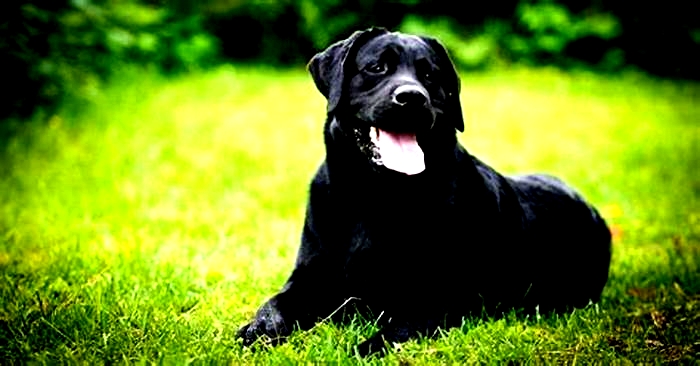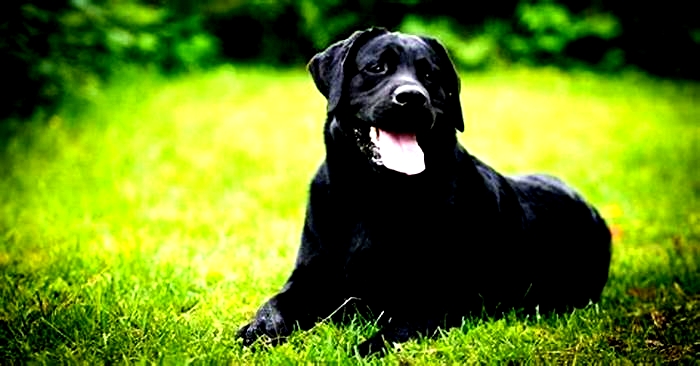What dog has the shortest lifespan
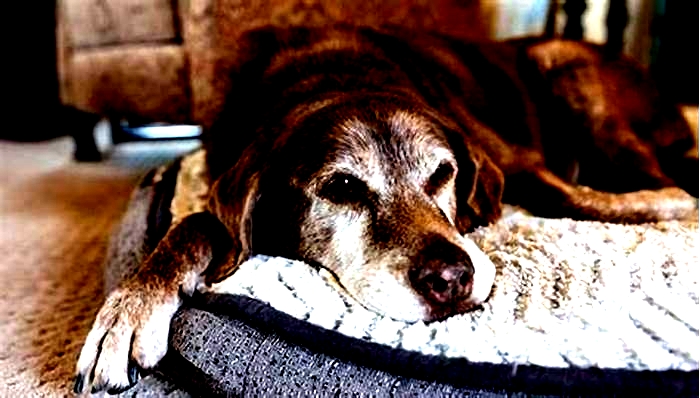
25 Dog Breeds With The Shortest Lifespans
When it comes time to decide on the right canine breed for your next family pet, there are many things to consider. One of these areas to learn more about is how long a dog will live. Certain breeds are known for long life, and others have a relatively short lifespan.
It is widely believed that mixed-breed dogs have somewhat longer lifespans than their purebred counterparts. Every dog is different, which is vital to keep in mind with any breed, purebred or mixed. Our comprehensive guide gives general information on 25 dog breeds with the shortest lifespans.
The information in our guide is intended to be a reference point, not a substitute for professional advice from a breeder or veterinarian. One of the most potent tools a pet owner can have is knowledge.
Average Dog Lifespan
According to the American Kennel Club, the average dog lifespan is between 10 and 13 years. Some breeds live much longer, and others live much shorter lifespans. Genetics and breeding certainly play a role in how long a dog will live.
In dogs, larger breeds often have shorter lifespans, which is slightly different from what happens in the rest of the natural world. In most animal kingdoms, larger-sized animals tend to live longer. For example, whales can live over 100 years. This correlation between size and longevity is flipped in dogs, with smaller dogs expected to live longer. This may be due to larger canines being prone to hereditary diseases.
Large breed dogs have an average lifespan of 8 to 12 years. In general, the larger the dog, the lower the lifespan. Because of this, it is essential that dogs, especially purebreds, undergo genetic and health testing to determine if they are predisposed to certain diseases or health concerns.
25 Dog Breeds With The Shortest Lifespan
You will find that many of the dog breeds discussed are large or giant breeds, which tend to have shorter lifespans than smaller breeds. These are listed below in order of length with the shortest average lifespan first.
Dogue de Bordeaux
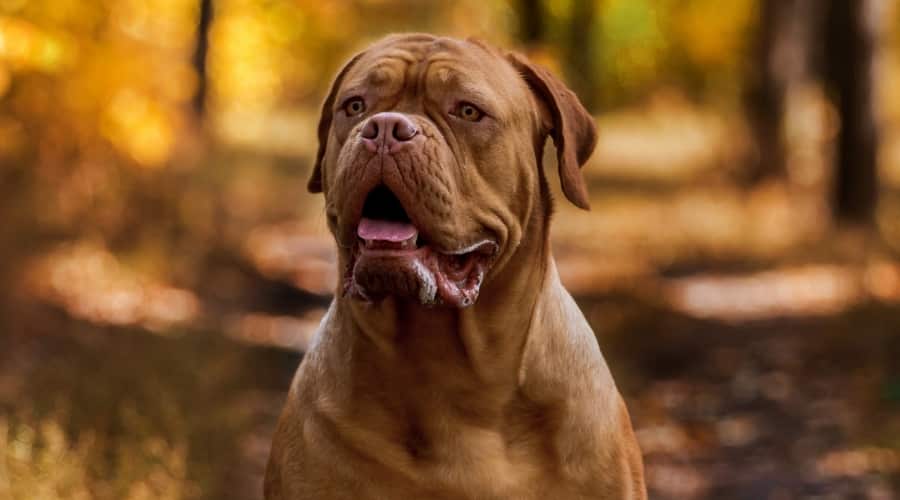
The Dogue de Bordeau is a huge, rare French dog breed. Males can reach 150 pounds and more. Females reach 100 pounds plus. This giant dog was bred to hunt livestock and as a guard dog. This enormous canine is thought to be one of the oldest breeds in France. Often also called the French Mastiff, this dog is truly massive. They stand 23 to 27 inches or so (shoulder height). Dogue de Bordeaux dogs have a short lifespan, just 5 to 8 years on average.
The Dogue de Bordeaux makes an excellent, loyal, and protective companion. However, they can be testy around smaller children. These big guys need to be in a one-dog-only house. Dogues can be prone to health conditions associated with their large size, primarily orthopedic and joint conditions. Additionally, Dogues are a canine breed with a short nose, making it easy for them to overheat, putting them at higher risk for breathing concerns.
Hereditary medical issues and large size contribute to the breeds shorter lifespan, including heart disease, cancer, hip dysplasia, elbow dysplasia, stomach torsion, and bloat. Food allergies are prevalent. Wheat allergies are common. This pooch is rare in both the United States and their native France.
Neapolitan Mastiff
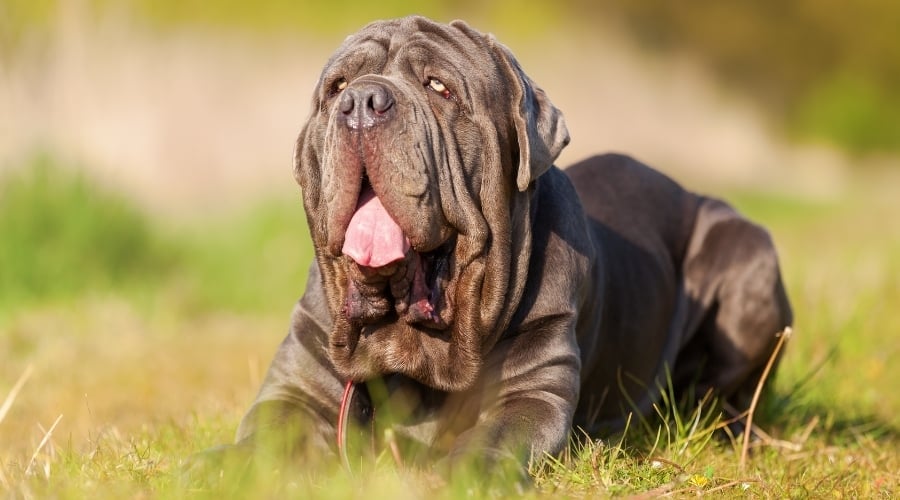
The Neapolitan Mastiff is a giant dog breed, reaching 110 to 200 pounds. This massive breed is also old, dating back at least 5,000 years. The breed is often called Mastino or Neo. They have Italian roots and were developed to be working farm dogs. These behemoths worked the land, pulling carts and working as loyal guard dogs. The lifespan of this big boy is 7 to 9 years.
Females weigh 110 pounds or more, and males reach at least 150 pounds, usually over 200 pounds. Paw to shoulder females measures about 29 inches, males up to 31 inches on average. There is nothing small about this dog. That includes attitude and drool, and this dog has pendulum jowls. Though he may look big and scary, Neo is a big teddy bear with a stubborn streak. That streak can make training challenging. In fact, this breed is known never to be fully obedient.
The Neapolitan Mastiff is a rare canine to be found in America. Finding one may be a challenge, and raising one is a big commitment. Though he looks scary, this breed is a big sweetie who loves people. They do not love other dogs. This guy likes to be the center of attention. He will also eat every scrap of food in sight. Like many other large breeds, the Mastino is prone to cardiac disease, namely cardiomyopathy. Additionally, conditions like obesity, hip and elbow dysplasia, eye concerns, and bloat. This breed is known for cherry eye, a condition where the corner of the eye becomes irritated and red.
Irish Wolfhound

A large hunting hound, the Irish Wolfhound, hails from ancient times. His ancestors chased game as far back as 391 A.D. This breed is the tallest of all the breeds in the canine kingdom. Females stand a minimum of 30 inches paw to shoulder, males a minimum of 32 inches. Females weigh at least 105 pounds, usually more. Males hit at least 120, often 180 or more. The breed lives on average 6 to 8 years.
Despite their generous size, these giants are quite affectionate to people and other dogs. They are very needy and love cuddles. This breed does not like to be left alone and can suffer from separation anxiety. They get anxious and destructive when left alone for too long and, with their generous size, can make a giant mess.
They have short to medium-length double coats of wiry fur. Their faces have a shaggy appearance with long hair flopping in the eyes. The Irish Wolfhound is healthy but can be prone to many of the same conditions that plague other large breeds. This includes cardiac disease, eye issues, bloat, hip and elbow dysplasia, cancer, and liver shunts. Additionally, this breed is known to develop pneumonia, often in conjunction with other conditions like infection and kennel cough.
Mastiff

The Mastiff, also known as the British or English Mastiff, is one of the biggest dogs around. They are also one of the most ancient canines we know of. Drawings and images of these colossal dogs date back to ancient Greece, Egypt, and Babylon. Mastiffs and other giant breeds have long served as work dogs, guard dogs, and gladiator-type fighters.
Coming face to face with a Mastiff is not an experience one soon forgets. They are genuinely massive. Mastiffs have thick, muscled bodies with square-shaped, heavy heads. They have floppy ears, droopy jowls, short muzzles, and markings like a black mask around the nose and eyes. Females average 120 to 170 or more pounds and stand 27.5 inches or taller. Males tip the scales at 160 to over 230 pounds, standing at least 30 inches tall at the shoulder. Mastiffs live 6 to 10 years on average. The largest Mastiff to ever live was named Zorba from London. He weighed in at a mind-blowing 345 pounds at his largest. Yes, a 354-pound dog is a real thing.
Though they look like giants and scare off just about anyone who sees them, the Mastiff is a friendly, patient, intelligent, and intently loyal canine companion. They love to cuddle but are not an excellent choice for families with young kids due to their genuinely gigantic size.
Bullmastiff

The Bullmastiff is slightly smaller, a close cousin to the colossus known as the Mastiff. He often gets confused with the Mastiff but is actually a mix of Mastiff and Bulldog. Bred in merry old England in the 19th century, the Bullmastiff was the product of breeders hoping to create the ideal guard dog. They have also been called the Gamekeepers Night Dog as they were developed to help gamekeepers protect large country estates from poachers.
The Bullmastiff is big but not as large as the Mastiff. They reach between 100 to 140 pounds fully grown and stand 24 to 26 inches at the shoulder. These dogs have substantial drooping jowls. They are incredibly drooly animals. Bullmastiffs look much like the Mastiff with a flat Bulldog face. They are often confused for the giant Mastiff breed. This breed usually has a brindle-colored coat.
This breed lives 7 to 10 years on average. Like many other larger canine breeds, Bullmastiffs can be susceptible to some different health conditions due to their enormous size. This included brachycephalic issues that come with a flat face. Bull Mastiffs are also at risk for eye dysfunction, cardiac issues, hip and elbow dysplasia, thyroid malfunction, and cancer.
Great Dane

The mighty Great Dane is one of the most recognizable and beloved dogs in the entire world. It is believed that this canine breed has ancient roots, as far back as 3000 B.C. The modern Great Dane has been traced back to 16th century Germany.
The Great Dane is a well-known giant-sized canine. Fully grown, they weigh between 110 and 175 pounds. These are very tall dogs standing between 28 and 32 inches tall. The worlds tallest dog on record is a Great Dane named Zeus, who stood an impressive 44 inches tall. They have long, lanky legs and long thin tails. This breed is also known for prominent droopy jowls and lots of drool. Great Danes have an average lifespan of 7 to 10 years.
Great Danes are often called gentle giants and referred to by owners as massive babies. They do not know their own size, and even if they do, they think they are the perfect-sized laptop. Despite their prominent appearance, these dogs are incredibly sensitive and get scared quickly. They do not make excellent guard dogs but are fantastic family pets for households that can handle a dog of this size. As with many other giant breeds of dogs, Great Danes are prone to health conditions like hip dysplasia, cardiac issues, eye concerns, and thyroid malfunction.
Bernese Mountain Dog
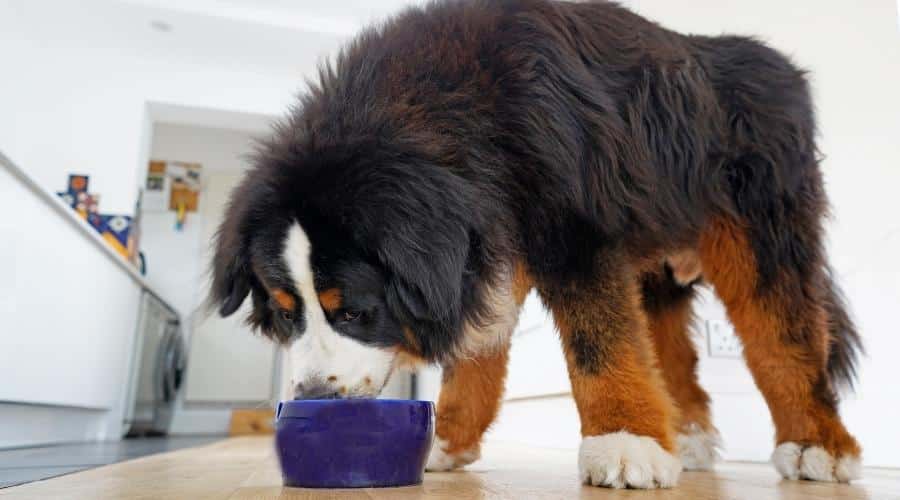
The Bernese Mountain Dog is a top-rated family pup. The breed is also highly used in the therapy industry as well. This breed has a long history in Switzerland and has worked on Swiss farms for at least two thousand years. The breed is thought to have been derived from Mastiff or Molosser-type breeds and brought to Switzerland in the 1st century by the Romans. The Bernese Mountain Dog is named after the area of Berne, the luscious agricultural area in Switzerland that produces both chocolate and cheese, two of Switzerlands biggest exports.
A Bernese Mountain Dog weighs between 80 and 115 pounds, fully grown. They stand between 23 and 27 inches tall from paw to shoulder. This is a hairy breed known for gorgeous tri-color coats. This pups ground coat is black with rust and clear white markings around the face, chest, legs, and under the tail. Additionally, this is a canine breed known for looking like they are smiling. The Bernese Mountain Dog has an average lifespan of about 7 to 10 years.
This breed is energetic, constantly playful, and known for being rambunctious. Because of their generous size, they are at risk for some health conditions. The Bernese Mountain Dog is also prone to cancer, panosteitis (self-limiting lameness), and bloat, among other things. This contributes to their shorter lifespan.
Weimaraner

The Weimaraner is a German hunting dog. They were developed in Weimar, Germany early in the 19th Century to aid nobles in their hunting excursions. They are sporting dogs, bred for physical ability and mental prowess. They were bred historically to hunt for big game like deer, wolves, and even bears. These dogs were not available to the public easily and did not make their entrance in America until the 1930s. Todays Weimaraner is most often a hunter of birds and small game and sometimes hunts as a water retriever. They are known for their friendly, loving nature. They love to be around children, do well with other dogs, and when properly trained can make fantastic family pets.
These dogs are large, males reach 70 to 90 pounds fully grown, and females reach between 55 and 75 pounds. They live on average 10 to 13 years. Typically, they have short, silky hair, which is easy to groom. As a large breed, they can be susceptible to certain medical conditions. Gastric torsion is a profoundly serious issue common with this breed and is life-threatening. It is according to the AKC, the most serious health issue this breed faces. This breed also has a high tendency to bloat. They need to eat smaller meals throughout the day to help with digestive issues like this
Chow Chow

The Chow Chow is a highly recognizable breed for its close resemblance to a bear and distinctive blue tongue. As they are commonly referred to, the Chow is believed to be one of the oldest canines in the world. Depictions of chows have been found in pottery and ancient artifacts dating back to Chinas Han dynasty around 200 BC. Chows are extremely popular breeds in China and worldwide.
Chows are medium-sized dogs reaching about 45 to 70 pounds as adults and standing 17 to 20 inches tall. Their lifespan, on average, is about 8 to 12 years. This breed is healthy but can be prone to diseases like hypothyroidism and hip and elbow dysfunction. Additionally, the Chow is prone to eye issues, including progressive retinal atrophy and entropion. Entropion is a common condition for chows characterized by an inward rolling eyelid that irritates and eventually injures the dogs eyeball. This condition can lead to complete blindness. They also tend to pack on the pounds quite easily and can develop health issues related to obesity.
Chows are known for being a very independent breed unless playful than many other canines. Chows have been described as feline-like due to their independent streak. They do not care for strangers or other dogs and are not the best breed to have children around.
Scottish Deerhound

As the name suggests, the Scottish Deerhound is an old breed of canine believed to have been in the area known as Scotland long before the Scottish themselves arrived there. They are called deerhounds because they would chase the 400-pound wild Red Deer. These regal pups were popular companions of royalty and nobility.
The Scottish Deerhound is often confused with the Irish Wolfhound due to their similar shaggy appearance. The Scottish Deerhound is a smaller breed than the Wolfhound, averaging 75 to 110 pounds for males and 75 to 95 for females. They are tall, reaching 28 to 32 inches tall. This breed lives about 8 to 11 years. They descended from the ancient Greyhound breed.
The Scottish Deerhound has a charming temperament, is affectionate but not clingy, intelligent, and brave, but not aggressive. While they are large, they do not make good guard dogs because they pay no attention to new people. The Scottish Deerhound is a sighthound, hunting based on what they see. Because of this, they tend to be a breed that is hard to take off-leash or in crowded places as they will chase anything that crosses their line of sight.
Bulldog

There is no mistaking the Bulldog for any other canine. These thick, stocky, well-muscled dogs are beloved companions. They are easily recognizable for their large heads, loose skin, flat nose, furrowed brows, tiny ears, and big choppy mouths. Their short muzzles and undershot jaw give the Bulldog his unique expression. They are also commonly called the English or British Bulldog. This breed has its roots in England and descended from large fighting Mastiffs.
Bulldogs have a much bigger reputation than they reach in size. They are medium-sized dogs that reach 40 to 60 or so pounds when fully grown. Bulldogs stand about 14 to 15 inches high and live 8 to 10 years on average. Because of their flat faces, Bulldogs are prone to breathing difficulties. They are well known for snoring and snuffling for the same reason. These dogs also suffer from skin allergies, gastric torsion, eye issues, joint concerns, and bladder stones, among other conditions.
They love children and do very well with other pets in the household if they are appropriately socialized. They do not do the best with cats, as they have a high instinct to hunt smaller prey, so they may do better in homes that only have dogs. This breed is known for its stubborn streak, making them a challenge to train. However, they love food, and it is an excellent motivator to help them learn commands and listen.
Saint Bernard

The Saint Bernard is a large friendly canine breed initially bred to thrive in the wintry frigid conditions of the Swiss Alps. This breed is traced back to a hospice in the western Alps founded by a monk named Bernard of Menthon around 1050. The great Saint Bernard Hospice is located in an icy, treacherous snowy pass named after Saint Bernard. The founding monk was worried about travelers crossing the dangerous mountain path and founded the Hospice to give them a safe spot of refuge. The Saint Bernard dogs were used as guides and rescue dogs for those traversing the snowy Alps.
The long-haired Saint Bernards we know, and love today descend from these early rescue dogs. Though the breed today is commonly associated with long fluffy coats, the earlier breed did not. In fact, the long coats made their work harder as they became heavy with snow and ice.
The Saint Bernard is well known for being a large, heavy dog. Males reach about 160 pounds as adults and females about 130 on average. They stand anywhere from 25 to over 30 inches at the shoulder. The enormous size may contribute to this breeds shorter lifespan. They live on average 8 to 10 years.
The Saint Bernard is a giant teddy bear of a dog who loves people. This breed is known as nanny dogs because of how well they get along with children. They are stubborn, hard to train, and need regular grooming due to their long fluffy coats. However, Saint Bernards will always be one of the most popular canines out there.
Rottweiler

Rottweilers, also called Rotties, are loyal working pups known for their prowess as guard dogs. This breed has roots among the ancient Romans, used as herding dogs as the empire was built up. These ancient ancestors bred with other canine breeds along the way, and in the German town of Rottweil, these crossbreeds became loyal herding dogs for local butchers.
Rottweilers are instantly recognizable for their portly size and distinct coat. Rottweilers are always black with lighter-colored markings on their faces, chests, legs, and even feet. Adult rottweilers can weigh between 75 to 110 pounds. Females tend to be smaller. The adult dogs are tall, standing 22 to 27 inches at the shoulder. On average, Rottweilers live 8 to 10 years.
Rottweilers are natural guard dogs. They were bred to be hardworking, protective, and dominant. Rottweilers have often been called an inherently aggressive breed. They require continuous, regular training and close monitoring. They are very protective, which can cause aggressive, intimidating behavior, especially around other animals and strangers.
Rottweilers are prone to several health conditions, contributing to their shorter lifespan. Progressive retinal atrophy, cardiomyopathy, subaortic stenosis, Addisons disease, Von Willebrands disease, cataract issues, elbow, and hip dysplasia, and osteochondrosis of the knee and shoulder are among the conditions this breed is prone for. Many of these conditions are genetic and can be inherited.
Newfoundland

Newfoundland is a beloved breed of dog. Where the breed originated is a bit of a mystery. However, it is believed they are from the Canadian province of Newfoundland and Labrador. One widely believed theory is that Newfoundland dogs are descendants of native canines mixed with Great Pyrenees, creating the Newfoundland breed we know and love today. Genetic testing shows them as close relatives of Canadian retrievers, including Labrador Retrievers, Golden Retrievers, and Nova Scotia duck-tolling retrievers.
These dogs are large, heavy-boned, muscular animals. They have large heads with deep-set small eyes. The Newfoundland has a double coat consisting of an oily outer coat in a softer undercooked. This helps them survive the cold temperatures of Canadian winters and creates a water-resistant texture for their coats.
Newfoundlands reach 100 to 150 pounds fully grown. They have a lifespan of 8 to 10 years. They are friendly and known for a superior work ethic. These dogs have a sweet demeanor known to be very loving, gentle, and patient.
Greater Swiss Mountain Dog

The Greater Swiss Mountain dog is believed to be a descendant of Julius Caesars famed war dogs. Big in size and protective in nature, these rare giants are a relative of the Bernese Mountain dog. Also called the Swissy, they are one of four Swiss breeds. Greater refers to this breed being the original and most giant Swiss mountain dog breed. This pooch is found all over Switzerland.
The Greater Swiss Mountain dog is a large to almost giant-sized canine and can reach over 140 pounds at total growth. These dogs usually weigh between 85 and 140 pounds or more. They stand 23 to nearly 29 inches tall, paw to shoulder. Females are smaller than males, but both can get quite large. They are sturdy, tall, muscular dogs with large heads and broad muscles. This breed always has brown eyes. One distinctive feature of the Swissy is their tri-colored coat, black, white, and red. This dog also often has a white cross-shaped marking across the chest.
As with other large and giant dog breeds, the Greater Swiss Mountain dog has a short lifespan of 8 to 11 years on average. They are a healthy breed, but like many other heavier canines, they can suffer from elbow, hip, and shoulder dysplasia. This breed is prone to eye issues, including progressive retinal atrophy and age-related cataracts. The Swissy is more prone than other dogs to have splenic torsion, which happens when the spleen rotates and fills with blood. This is a life-threatening condition.
Broholmer

The Broholmer is a large dog, similar to a mastiff, with a rectangular body and large, huge head. These dogs have roots in Denmark. They were typical canines to see around, particularly around the Copenhagen area. These were Danish working dogs, guard dogs, and herders. These dogs were common in both city and rural areas.
This breed is large, reaching 90 to 150 pounds and standing anywhere from 27 to 29 or more from paw to shoulder. This dog has a lifespan of eight to 10 years. They are known to be a healthy breed, though they may be prone to some of the same orthopedic issues as other large, heavy-boned dog breeds.
The Butchers dog can have a black, red-golden, or yellow coat with white and black markings. They are quite agile, full of energy, and love to accompany humans on adventures. Due to their generous size, they may not be suitable for tiny homes and must be supervised around young children.
Borzoi

The Borzoi is a unique, elegant-looking medium to large dog breed. This regal breed belongs to the hound family and is a rare breed to find running around the dog park.
They are a medium breed, with medium to a longer length, silky coats. The Borzoi reaches 60 to 105 pounds more as adults. Males tend to be heavier. They range from 26 to 34 inches tall. This breed looks like a greyhound in body, with long thin muscles now our bodies and long necks. Borzois are very calm and known for being gentle, laid-back dogs.
Borzois live 10 to 12 years on average. This is a lengthy lifespan for a larger dog breed compared to some of the other breeds mentioned here. Borzois are healthy overall but can be predisposed to some conditions like heart problems, thyroid concerns, eye concerns, and Degenerative Myelopathy. Their coats need daily or once or twice every other day grooming to stay soft and silky.
Leonberger

The Leonberger is a canine breed bred solely for companionship. They are another big to giant breed. Males weigh 110 to 170 pounds on average. Females reach 90 to 140 pounds. They stand 25 to 29 inches tall, paw to shoulder. Males are larger, with a noticeably stocky build and lion-like mane. Females do not have a mane and are slender, more feminine-looking.
The Leonberger has a life span of 9 to 10 years. They are relatively healthy but only make it to about nine years of age before they start to deteriorate. Like many other purebred and larger dog breeds, the Leonberger can suffer from joint dysplasia, eye conditions, hypothyroidism, etc. This canine suffers from two types of polyneuropathies. Leonberger polyneuropathy is an inherited neuromuscular disease. Leukoencephalomyelopathy is caused by degradation in the white matter of the central nervous system.
This pooch is well known for its extra-thick double coat. This coat keeps the dog warm in cold months and regulates his temperature to keep him cool in warmer months. It is a misconception that this breed is hot because of their heavy fur. This fur is actually one of his bodys ways of regulating temperature. All dogs of this breed have a black mask, and it is common for the hair on their bodies to be black-tipped.
Boxer

The Boxer is a medium-sized to a generously sized dog. Adults can weigh 48 to about 85 pounds and stand 22 to 25 inches tall, paw to shoulder. The Boxer has a lifespan of eight to 10 years.
An early ancestor of todays Boxer is believed to belong to the same family as Bull Terriers, Bulldogs, and other Mastiff-type breeds. Todays Boxer is smaller than those ancestors and appeared around the 1880s. During World War One, they served as guide dogs, police dogs, and in the German military. In the 1950s, the Boxer started to gain popularity as a family dog.
This breed is sometimes used as seeing-eye dogs and has become an exceedingly popular pet, ranking number 10 on the American Kennel Clubs breed popularity chart. These dogs are outgoing, energetic, and highly intelligent. They have muscular chests and thin waists. The Boxer has a round face, with a lower jaw longer than the top.
Doberman Pinscher

The Doberman Pinscher is a canine widely associated with being a tough cookie. This breed is often used in movies and depicted as a bruiser. The pup is thought to have German roots. While they can make good family and companion dogs, this breed tends to be dominant and needs an experienced dog owner.
Doberman Pinschers are a big breed, weighing 60 to 100 pounds on average. They live about 10 to 12 years. As with other purebred and larger breeds, they can be more likely than others to suffer from health concerns. Heart issues are common. At least 50 percent of the breed is thought to have cardiomyopathy, an enlarged, defective heart. This can lead to heart failure and sudden death if not treated.
Dobermans, or Dobies, need a lot of exercise. They are muscular, athletic, and energetic. They can make good family pets with ongoing training and supervision. The Doberman has an intense personality but can be a big sweetheart.
Cane Corso

A Cane Corso is a breed one will not forget if they ever meet one. They have a unique appearance and some of any breeds most impressive jaw strengths. They have a tremendous bite force of 700 PSI, comparable to that of lions. The Cane Corsos head is enormous, with square muzzles and short faces. Some have heavy jowls and lots of drool. Fun fact, this is a very gassy canine. They gulp a ton of air when they eat, leading to frequent flatulence.
Cani Corsi are large. Along with the Neapolitan Mastiff, they are known as the Italian Mastiffs. They reach 85 to 120 pounds or more. Some can reach giant status. The average lifespan for a Cane Corso is about 10 years. 12 years is relatively long-lived for this breed.
The Cane Corso needs an owner that takes charge, or they will. They are intelligent, loyal, and loving. If they are introduced at an early age, the Cane Corso will do well with other animals and children. If not, they need to be the only pet or child. This breed can be dominant and stubborn, not a wonderful choice for first-time or hesitant dog owners.
Old English Sheepdog

There is not a sweeter dog breed that one could ask for than the Old English Sheepdog. This fluffy bundle of love is also called the Bobtail. This breed is uncommon in the United States. The breed has been made famous by movies like The Shaggy Dog. This dog is technically neither English nor a Sheepdog.
The Bobtail has a unique look, reaching 80 to 100 or more pounds. Covered in a shaggy double coat, they look enormous, almost otherworldly. They live about 10 to 12 years. Overall, they are healthy but can inherit deafness. They can be affected by hip dysplasia, common for larger breeds. English Sheepdogs are highly likely to develop eye issues, most commonly progressive retinal atrophy and cataracts.
Rhodesian Ridgeback

The Rhodesian Ridgeback is a medium-sized pup that originated in Africa. They tend to have a different personality at home than in public. Sweet and affectionate to those he loves, solid and protective. This breed has a dominant personality and can be aggressive to those they do not personally know.
This breed is agile and incredibly fast, with long legs and many muscles. They were bred to be big-game hunters. Large, high-set ears, intuitive eyes, and a long neck give them a curious, almost investigative facial expression. This dog has a unique ridge of hair along the spine, which is what the breed is known for.
The Ridgeback reaches 75 to 80 pounds and stands about 27 inches tall. They live 10 to 12 years on average. These dogs need a lot of attention and a firm hand when training and are not suitable for people who have not had experience with stubborn, dominant breeds before.
Bloodhound

The Bloodhound is a lovable pup with a distinct look. The large, even giant breed has a long narrow face, loose skin, and floppy ears. A Bloodhounds face has been described as noble and dignified, with a sense of wisdom. This breed has a keen sense of smell and is often used as police or search and rescue dogs.
The Bloodhound is a breed that is both fun and adventurous and laid back and lazy. He is either using his nose to sniff out and chase things or taking a nap. For those looking for a less needy breed of dog, the Bloodhound may be an excellent choice. These dogs are usually fairly laid back, with a happy temperament. They are also known to be incredibly stubborn, if not the most stubborn canine breed people have encountered.
Bloodhounds are enormous, weighing 80 to 110 pounds as adults. Males are more significant than females. Bloodhounds are also a tall breed measuring between 23 and 27 inches tall from paw to shoulder. Overall, these dogs are relatively healthy and live on average 10 to 12 years. As with other large dogs, they are prone to cardiac concerns, eye conditions, and hip and elbow dysplasia. Bloodhounds can suffer from skin fold dermatitis due to moisture trapped in their loose skin.
French Bulldog

One of the smallest pups on our list, the small yet mighty French Bulldog, or Frenchie, is a favorite among dog lovers.These adorable little guys pack a lot of personality into a small package. They weigh just 20 to 28 pounds fully grown and stand about 11 or 12 inches tall. The Frenchie lives just 8 to 10 years on average.
Frenchies are small, stocky dogs with bodies made of firm muscles. They have signature bat-shaped ears, small faces, short muzzles, snub noses, and well-pronounced jowls with black lips. Frenchies have glossy single-layer coats. They are easily recognizable for their unusual appearance.
French Bulldogs are loyal, friendly, and love to please. They can have a stubborn streak and get overly protective, so they need a lot of attention. Frenchies are not big on barking and make terrible guard dogs but do make great pets. These tiny bulldogs are good in small, cramped spaces as long as they get enough exercise.
Contributing Lifespan Factors
Many factors affect how long any individual dog will live. Breeding and bloodline play a significant role. Nutrition, amount of exercise, grooming, dental health, and unique living environment will impact how long a dog will live.
Nutrition is of particular importance for a dogs overall health and lifespan. Cheap dog food and those brands that use a lot of fillers and substitute products do not provide dogs with the optimum balanced diet of nutrients they need to be healthy. Long life, along with good health, starts with nutrition. Exercise level plays a prominent role, as overweight dogs are at risk for many curious health concerns.
Dogs, regardless of breed, need regular care, high-quality food, and a considerable commitment from their owners. Owning a dog is a privilege and a great responsibility. How animals are taken care of dramatically impacts how long they will live and their quality of life. Always talk to your veterinarian about any specific health concerns for your dog and find out what kind of food and supplements they may need. Dogs will require different levels of care as they age. Senior dog care can significantly impact how long a dog will live.
Disease like cancer is one of the most common causes of early death in canines. Cancer is the leading cause of death in large dog breeds. It is not known why larger breeds develop cancer more than smaller breeds. This is something scientists and researchers have long worked to find out.

Final Thoughts
A large part of the responsibility of pet ownership is knowing how long to expect your canine companion to be around. Understanding the distinct factors that play into a dogs expected lifespan, including breeding, can help owners make the best decisions for their dogs.
It is undeniable that some dogs have longer expected lifespans, and some dogs have shorter expected lifespans. Large and giant breed dogs tend to require more care and have shorter expected life spans than most smaller dog breeds. Keep this information in mind before committing to a massive breed.
It is always a good idea for a pet owner to understand the particular things like genetic health conditions, lifespan, and personality traits that make each breed different. Get to know your pup, so you know what to expect for these dogs with shorter lifespans.

